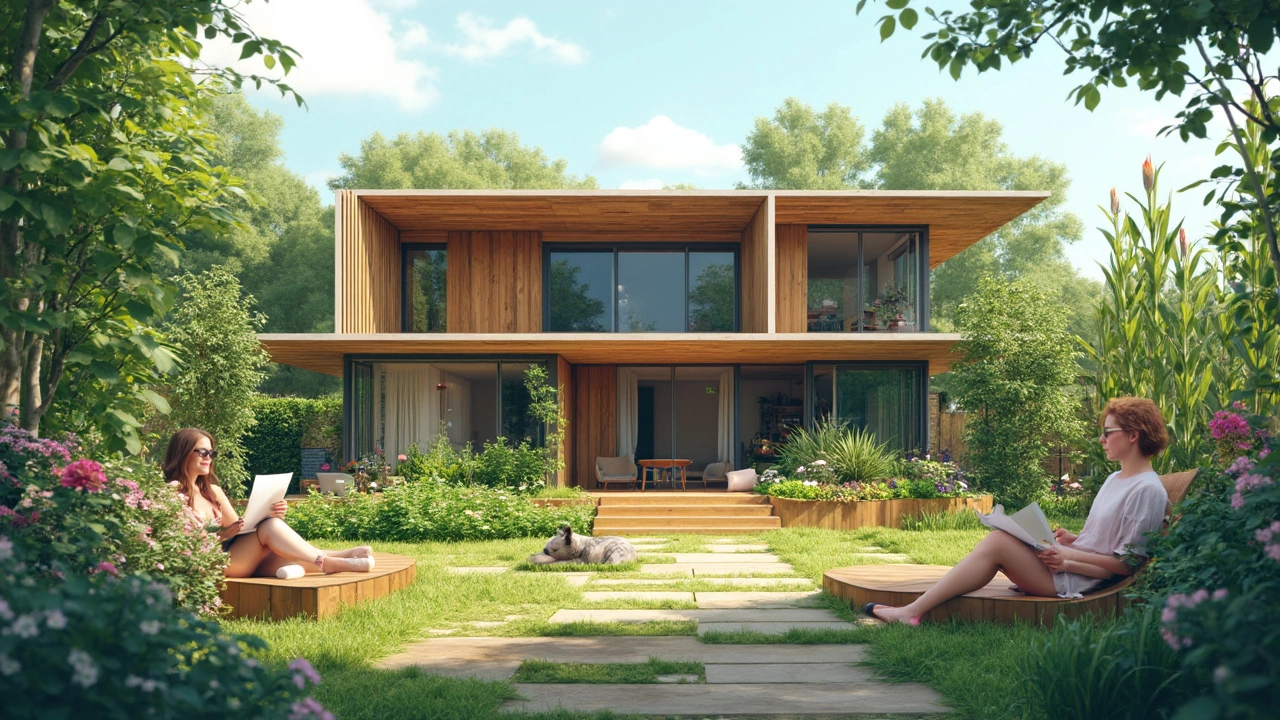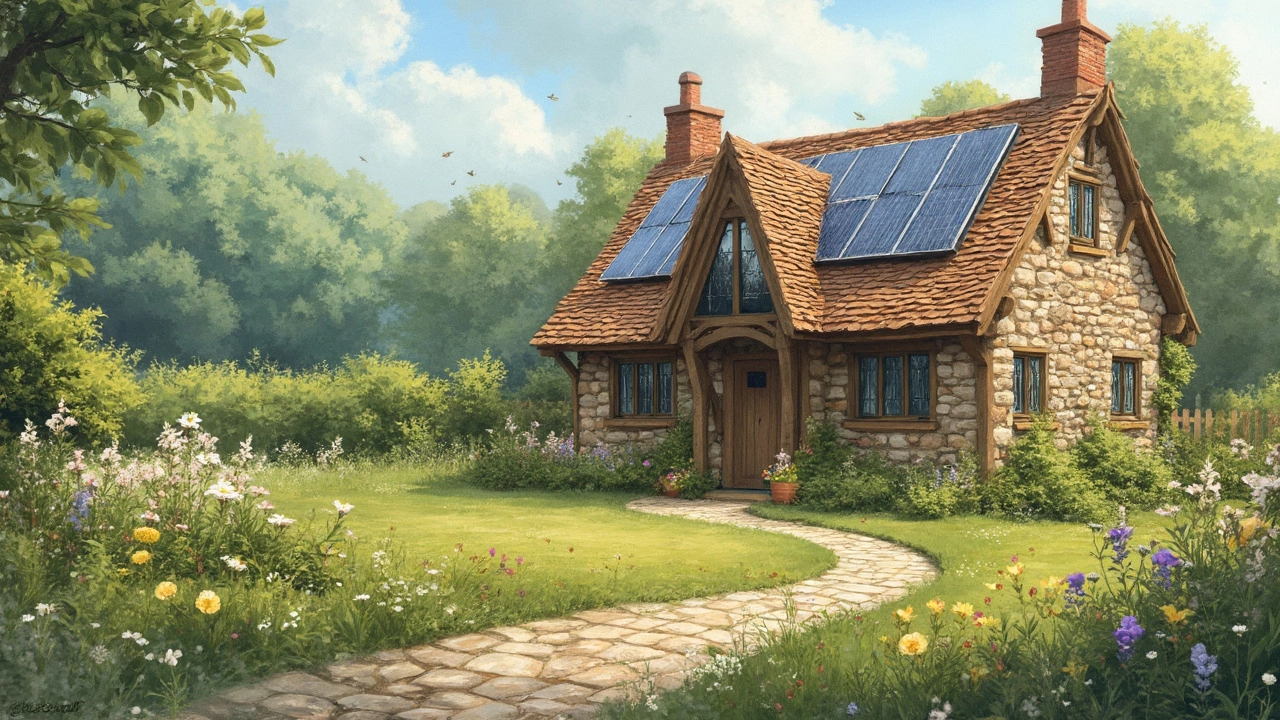Thinking about building a home that's cozy and kind to the planet? Eco-friendly cottages might just be what you're looking for. These charming homes aren't just about looking cute in the countryside; they're designed to minimize impact on the environment while keeping your living space stylish and comfortable. But what makes a cottage truly eco-friendly?
Let's break it down with some basics. First off, the materials you choose play a huge role. Think reclaimed wood, recycled metal, and local stone. These not only reduce waste but often cut down on transportation emissions too. It's like giving old materials a fresh, new purpose!
- Understanding Eco-Friendly Building
- Sustainable Materials
- Energy-Efficient Designs
- Tips for Building Green Cottages
Understanding Eco-Friendly Building
When it comes to eco-friendly homes, it’s all about smart choices that favor the environment without compromising on comfort. The basic idea is to design and construct homes that lower carbon footprints. This means selecting materials, techniques, and systems that either have a low environmental impact or significantly reduce energy consumption over time.
Choosing the Right Materials
One of the key aspects is using sustainable materials like bamboo, which grows fast and can be harvested without damaging the ecosystem. Other options include straw bales and recycled metal. But it's not just about the material itself. It's also about sourcing them locally to cut down transportation emissions. That’s why opting for locally sourced stones or reclaimed wood can make a real difference.
Energy Efficiency
A big plus for sustainable cottages is energy-efficient design. Think about passive solar design, which uses the sun’s energy for heating during the winter and keeps the house cool in summer. Windows play a crucial role here; placing larger windows on the south side of the home typically captures more natural light and warmth. You can also think about adding energy-efficient windows to significantly cut down on heating costs.
Renewable Energy Systems
Using renewable energy is a major part of eco-friendly building. Solar panels are popular not just because they produce renewable energy but because technological advancements have made them cheaper and more efficient. Some homeowners also invest in geothermal heating which harnesses the Earth's natural temperature to provide consistent, efficient heating and cooling.
Water Conservation
Water is a precious resource, and smart eco designs incorporate ways to save it. Low-flow faucets and showerheads are a start. For those who've got space, rainwater harvesting systems are a fantastic addition. Collecting rainwater reduces reliance on municipal water systems and can be used for watering gardens or even flushing toilets.
| Feature | Potential Savings |
|---|---|
| Solar Panels | Up to 30% on energy bills |
| Energy-Efficient Windows | 10-25% on heating and cooling |
| Low-Flow Faucets | 60% reduction in water usage |
Understanding and applying these principles not only helps the planet but can lead to significant savings over time. Your eco-friendly cottage becomes more than a beautiful place to live; it becomes a statement of your commitment to sustainability.
Sustainable Materials
Choosing the right materials is a crucial step in building an eco-friendly home. It's all about picking things that are sustainable, renewable, and sometimes even recyclable. Let's dive into what makes these materials so special and why they're perfect for sustainable cottages.
Reclaimed and Recycled Materials
Reclaimed wood is a superstar in the eco-friendly world. It's basically giving old wood a second life, whether it's from old barns or leftover from another project. This not only saves trees but adds character to your green building.
Recycled metal, like aluminum and steel, is another cool option. Using what's already there instead of mining new materials reduces energy consumption and pollution. It’s a win for everyone, including the planet.
Bamboo: The Fast-Growing Hero
Bamboo is like that friend who's always around to help - it's fast-growing and super renewable. In fact, it can grow up to 3 feet in 24 hours under the right conditions! Using bamboo for flooring or furniture not only cuts down on deforestation but looks amazing too.
Cork: Not Just for Wine Bottles
Did you know cork is harvested from the bark of the cork oak tree every 9 years? That means the tree isn’t chopped down, making cork a renewable resource. It's perfect for flooring and insulation in energy-efficient designs.
Natural Stones
Using local stone like granite or slate can be a great move. It cuts down on the need to transport materials far distances, which means fewer emissions. Plus, stone is durable and lasts a long time, reducing the need for replacement.
When you're building or renovating a cottage, thinking about these materials isn't just about being trendy. It's about making choices that reduce your carbon footprint while making your home beautiful and comfy.

Energy-Efficient Designs
When it comes to energy-efficient designs in eco-friendly cottages, it's all about making the most of what nature provides. A big factor here is natural light. Designing your cottage with large windows and skylights not only bathes your space in sunshine but can also significantly cut down on your electricity bills.
Sustainable cottages often feature clever insulation techniques too. Think of it as wrapping your home in a cozy blanket—materials like wool, cork, and even recycled denim can help maintain comfortable temperatures year-round. This means less need for heating in the winter and cooling in the summer.
Smart Energy Solutions
Getting smart with energy solutions is another way to boost efficiency. Solar panels on the roof can harness the power of the sun, giving you free and clean energy. And let's not forget about wind turbines—if you've got the space and a good breeze, they can be a fantastic addition.
Appliance Efficiency
Looking at everyday appliances, picking those with high energy ratings makes a difference. Whether it's the fridge or the washing machine, energy-star-rated products use less electricity and water, fitting right into your green home goals.
Here's a quick stat that might spark your interest: an average solar panel system can cover around 70-100% of a small home's energy needs, depending on the system size and location. That's a lot of savings and reduces your reliance on non-renewable resources.
- Proper Ventilation: Look for energy-recovering ventilation systems. They not only recycle warm air but also improve air quality.
- Lighting: Switch to LEDs. They're a small change that makes a huge difference in reducing energy consumption.
- Orientation: Build with your cottage's direction in mind. South-facing windows can capture more winter sun while keeping the house cool in summer.
Creating an eco-friendly home isn't just good for the planet—it's good for your wallet too. By embracing these energy-efficient designs, you're not only helping reduce your carbon footprint but also creating a comfy, sustainable retreat.
Tips for Building Green Cottages
Building an eco-friendly home can sound daunting, but with the right tips, it becomes an exciting journey! Here's how to create a perfect balance of style and sustainability in your own eco-friendly homes.
Choose Sustainable Materials
Start by selecting materials that have a low environmental impact. Think about using recycled materials or sustainably sourced products. For example, reclaimed wood is not only trendy but gives a rustic charm that modern interiors often lack. No wonder many sustainable cottages feature this gorgeous touch.
Sourcing local materials is also essential. It cuts down on transportation emissions and costs. Plus, local stone and bricks tend to blend naturally with the landscape.
Energy-Efficient Designs Matter
An energy-efficient design can save you a ton on your utility bills and is a big win for the planet. Orientation matters: positioning your cottage to maximize natural light can reduce your reliance on artificial lighting. Consider adding solar panels; they are a brilliant way to harness clean energy.
- Install triple-glazed windows to keep warmth in during winter and out during summer.
- Use LED lighting to cut down on energy consumption.
- Plant trees strategically around the house for natural cooling.
Water Conservation is Key
Use rainwater harvesting systems to reduce your dependency on public water supply. A greywater recycling system can also minimize water waste by repurposing water from sinks and showers.
Smart Home Technology
Integrate smart home technology for maximum efficiency. Smart thermostats and lighting systems adapt to your usage patterns, ensuring you're not using more energy than needed.
Transforming a traditional cottage into a modern green building doesn't just help you save on costs but contributes positively to the environment. Plus, it makes your home a standout feature in the community.
